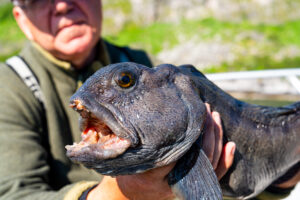 The wolffish, a unique and formidable predator of the ocean depths, is often misunderstood due to its menacing appearance. Known for its powerful jaws, elongated body, and large teeth that protrude from its mouth, this fish plays a vital role in maintaining the balance of marine ecosystems. Despite its intimidating look, the wolffish is an essential species in the food chain and is even valued for its economic and ecological significance.
The wolffish, a unique and formidable predator of the ocean depths, is often misunderstood due to its menacing appearance. Known for its powerful jaws, elongated body, and large teeth that protrude from its mouth, this fish plays a vital role in maintaining the balance of marine ecosystems. Despite its intimidating look, the wolffish is an essential species in the food chain and is even valued for its economic and ecological significance.
Characteristics and Habitat
Wolffish belong to the family Anarhichadidae and are primarily found in cold waters of the North Atlantic and Arctic Oceans. The most well-known species include the Atlantic wolffish (Anarhichas lupus), the spotted wolffish (Anarhichas minor), and the northern wolffish (Anarhichas denticulatus). They typically inhabit depths ranging from 200 to 500 meters, preferring rocky crevices and seabeds where they can ambush prey.
The wolffish’s most striking feature is its set of robust, conical teeth, which it uses to crush the hard shells of mollusks, crustaceans, and sea urchins. This diet helps control the population of these species, preventing overgrazing of marine vegetation and maintaining ecosystem stability. Unlike many fish, wolffish do not have swim bladders, which helps them remain close to the seafloor without floating upward.
Behavior and Reproduction
Unlike many deep-sea fish, wolffish exhibit a unique reproductive strategy. They are known for their monogamous behavior, with mating pairs forming strong bonds. Females lay large eggs, which are deposited in rocky crevices and guarded by the males until they hatch. This parental care is uncommon in most fish species and contributes to the wolffish's relatively low reproductive rate.
Wolffish are solitary creatures, typically living alone rather than in schools. They are also known for their territorial nature, defending their hiding spots aggressively against intruders. Their powerful bite not only helps them hunt but also serves as a defense mechanism against predators.
Ecological Importance and Conservation Status
Wolffish play a crucial role in marine ecosystems by keeping populations of shelled invertebrates in check. However, human activities, such as overfishing and habitat destruction, have put pressure on their populations. Trawling, in particular, has been detrimental, as it destroys the rocky seabed environments that wolffish rely on for shelter.
Due to these threats, the Atlantic wolffish is classified as a species of concern in some regions, and conservation efforts are being made to protect their habitat. Marine protected areas and sustainable fishing practices are essential in ensuring the survival of this fascinating species.
Wolffish in Human Culture
Although not as widely known as other fish species, wolffish are commercially valuable in some areas. Their firm, white flesh is prized in certain cuisines, especially in Northern Europe. Additionally, their thick, leathery skin has been historically used for crafting durable materials, including clothing and accessories.
Conclusion
The wolffish, with its unique appearance and important ecological role, is a remarkable species that deserves more attention and conservation efforts. Despite its fearsome looks, it is a vital part of marine biodiversity, helping to maintain the delicate balance of oceanic ecosystems. Protecting wolffish and their habitats ensures the health of marine environments for future generations.
Types of Wolffish
Wolffish belong to the Anarhichadidae family and are known for their large teeth and powerful jaws, which help them crush hard-shelled prey like crabs and mollusks. There are five main species of wolffish:
1. Atlantic Wolffish (Anarhichas lupus)
- Found in the North Atlantic Ocean, from the U.S. to Europe.
- Recognizable by its long body, large head, and prominent canine teeth.
- Also called Seawolf or Catfish in some regions.
- Primarily feeds on sea urchins, crabs, and shellfish.
2. Spotted Wolffish (Anarhichas minor)
- Found in the North Atlantic and Arctic waters.
- Identified by dark spots covering its body.
- Has a slightly smaller head than the Atlantic wolffish but is still a powerful predator.
- Less common in commercial fishing due to its habitat preferences.
3. Northern Wolffish (Anarhichas denticulatus)
- Also called the Broadhead Wolffish due to its wide skull.
- Found in deeper, colder waters of the North Atlantic.
- More streamlined and elongated compared to other wolffish species.
- Feeds on slow-moving prey like starfish and sea cucumbers.
4. Bering Wolffish (Anarhichas orientalis)
- Found in the North Pacific, especially in the Bering Sea and Arctic waters.
- Has a more muted coloration compared to the spotted wolffish.
- Prefers extremely cold waters and is less studied than other species.
5. Wolf Eel (Anarrhichthys ocellatus)
- Not a true wolffish but often grouped with them.
- Found in the Pacific Ocean, from Alaska to California.
- Has a long, eel-like body and a more flexible jaw structure.
- Prefers rocky crevices and kelp forests.
